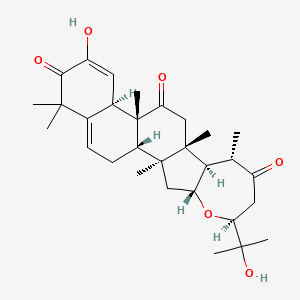| Authors | Title | Published | Journal | PubMed Link |
|---|---|---|---|---|
| Zhang JF et al. | [Comparison of preparing two polylactide nanoparticles loaded lipophilic anti-cancer herb drug by nanoprecipitation method]. | 2007 | Zhongguo Zhong Yao Za Zhi | pmid:17455462 |
| Molavi O et al. | Polymeric micelles for the solubilization and delivery of STAT3 inhibitor cucurbitacins in solid tumors. | 2008 | Int J Pharm | pmid:17681440 |
| Tannin-Spitz T et al. | Cucurbitacin glucosides: antioxidant and free-radical scavenging activities. | 2007 | Biochem. Biophys. Res. Commun. | pmid:17942079 |
| Chen J et al. | Trinorcucurbitane and cucurbitane triterpenoids from the roots of Momordica charantia. | 2008 | Phytochemistry | pmid:18045630 |
| Rao VS et al. | Evaluation of the purified fraction of Wilbrandia (c.f.) verticillata for antitumour activity. | 1991 | Mem. Inst. Oswaldo Cruz | pmid:1842011 |
| Beurel E and Jope RS | Differential regulation of STAT family members by glycogen synthase kinase-3. | 2008 | J. Biol. Chem. | pmid:18550525 |
| Maloney KN et al. | Actin-aggregating cucurbitacins from Physocarpus capitatus. | 2008 | J. Nat. Prod. | pmid:18959442 |
| Yang PQ et al. | Cucurbitacin contents in Hemsleya dolichocarpa. | 1991 | Am. J. Chin. Med. | pmid:1897490 |
| Abou-Khalil R et al. | Interaction of cucurbitacins with human serum albumin: Thermodynamic characteristics and influence on the binding of site specific ligands. | 2009 | J. Photochem. Photobiol. B, Biol. | pmid:19380237 |
| Patel SK et al. | Roles of nonpolar and polar intermolecular interactions in the improvement of the drug loading capacity of PEO-b-PCL with increasing PCL content for two hydrophobic Cucurbitacin drugs. | 2009 | Biomacromolecules | pmid:19655789 |
Cucurbitacin S
Cucurbitacin s is a lipid of Sterol Lipids (ST) class. The involved functions are known as establishment and maintenance of localization and nitric oxide biosynthetic process.
Cross Reference
Introduction
To understand associated biological information of Cucurbitacin S, we collected biological information of abnormalities, associated pathways, cellular/molecular locations, biological functions, related genes/proteins, lipids and common seen animal/experimental models with organized paragraphs from literatures.
What diseases are associated with Cucurbitacin S?
There are no associated biomedical information in the current reference collection.
No disease MeSH terms mapped to the current reference collection.
PubChem Associated disorders and diseases
What pathways are associated with Cucurbitacin S
There are no associated biomedical information in the current reference collection.
PubChem Biomolecular Interactions and Pathways
Link to PubChem Biomolecular Interactions and PathwaysWhat cellular locations are associated with Cucurbitacin S?
There are no associated biomedical information in the current reference collection.
What functions are associated with Cucurbitacin S?
Related references are published most in these journals:
| Function | Cross reference | Weighted score | Related literatures |
|---|
What lipids are associated with Cucurbitacin S?
There are no associated biomedical information in the current reference collection.
What genes are associated with Cucurbitacin S?
There are no associated biomedical information in the current reference collection.
What common seen animal models are associated with Cucurbitacin S?
There are no associated biomedical information in the current reference collection.
